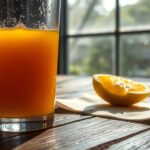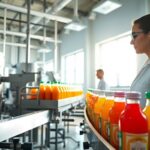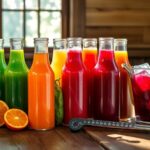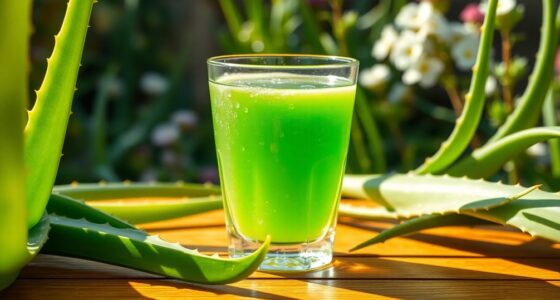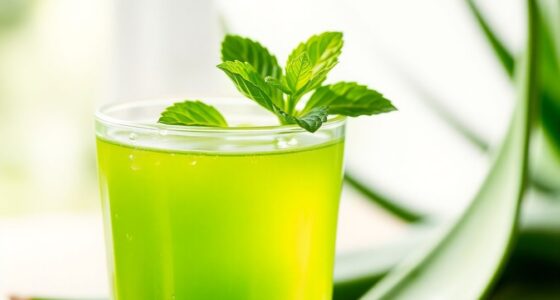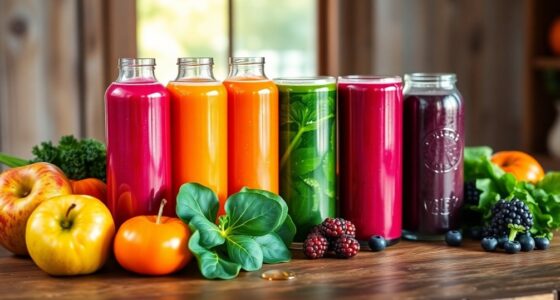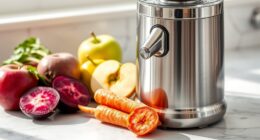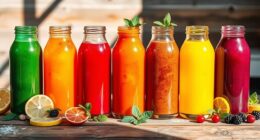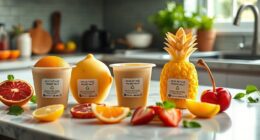Unpasteurized juice might seem invigorating, but you should be cautious. It can carry harmful pathogens like E. coli and Salmonella, increasing the risk of severe foodborne illnesses. Vulnerable groups, such as young children, pregnant women, and immunocompromised individuals, face even greater danger. Always check for pasteurization labels, and remember to refrigerate any unpasteurized juice right away. By understanding these risks, you can make safer choices for your health and well-being. There's more you should know about safe juice practices.
Key Takeaways
- Unpasteurized juice can contain harmful pathogens like E. coli and Salmonella, increasing the risk of foodborne illnesses.
- Vulnerable populations, including young children and pregnant women, face heightened health risks from consuming unpasteurized juices.
- The CDC estimates 76 million annual foodborne illnesses in the U.S., many linked to fresh produce, including unpasteurized juice.
- Unpasteurized juices must be refrigerated and consumed within three days to reduce the risk of contamination.
- Pasteurized juice is a safer alternative, significantly lowering the risk of foodborne illnesses for all consumers.
What Is Unpasteurized Juice?
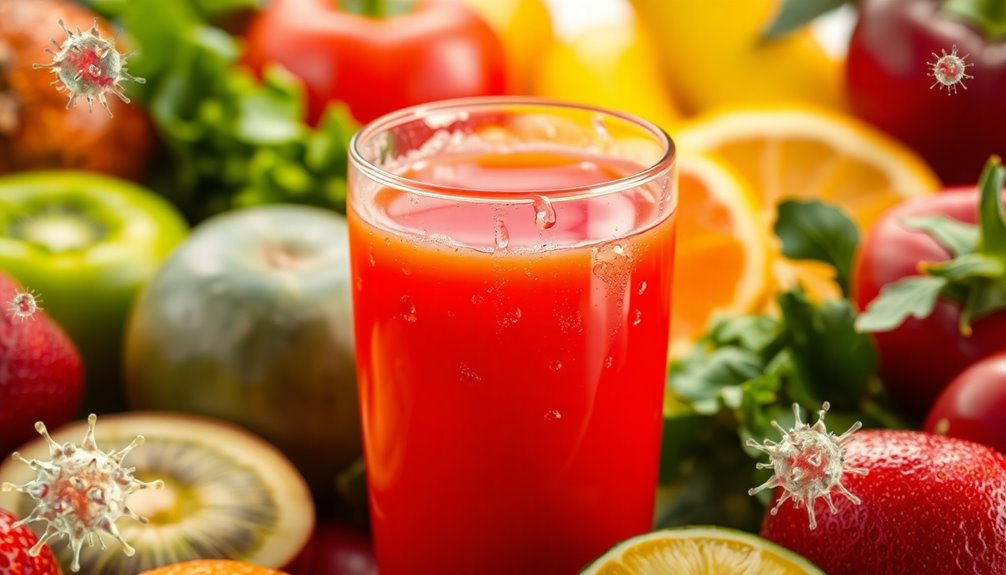
Unpasteurized juice, often called raw or fresh squeezed juice, hasn't gone through the pasteurization process that kills harmful pathogens. This means that while it can taste fresh and vibrant, it may also pose safety risks.
Common sources of unpasteurized juice include fresh produce, ciders, and artisan beverages, which can carry foodborne pathogens if not handled correctly. The FDA warns that vulnerable populations—like young children, pregnant individuals, and those with weakened immune systems—should avoid consuming unpasteurized juice due to the increased health risks.
Additionally, this juice typically has a much shorter shelf life, remaining fresh for only about three days. Warning labels about harmful bacteria must accompany unpasteurized juices sold in stores, though fresh juices from restaurants may lack such warnings.
The Risks of Consuming Unpasteurized Juice
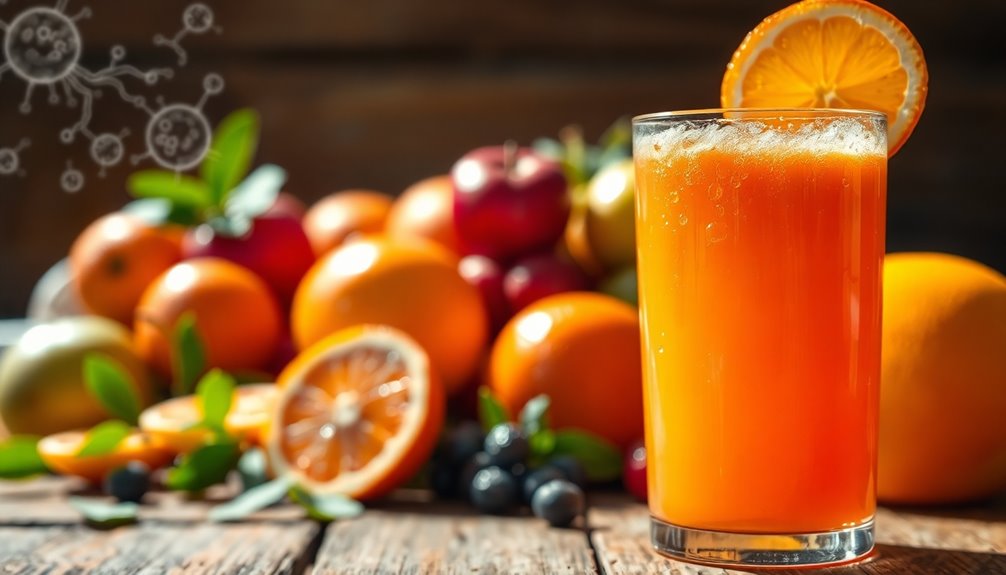
Fresh squeezed juice may seem like a healthy choice, but it carries significant risks that consumers should be aware of. Unpasteurized juices and ciders can harbor harmful pathogens like E. coli, Salmonella, and hepatitis A, putting you at risk of serious foodborne illnesses. To minimize the risk of contamination, it’s essential to ensure that any juice you consume is properly pasteurized. When choosing how to store your juice, consider buying a plastic juice dispenser; this can help maintain freshness while reducing the chance of introducing bacteria from handling or exposure. Additionally, always prioritize purchasing juices from reputable sources that adhere to safety guidelines.
This risk is especially concerning for those with weakened immune systems or vulnerable populations like young children and pregnant individuals.
- Contamination can occur at multiple stages, from growth to processing.
- The CDC estimates 76 million annual foodborne illnesses in the U.S., with many linked to fresh produce.
- Many eateries and farmers' markets sell unpasteurized juices without warning labels, increasing your exposure.
Additionally, consuming detoxifying juices can be a safer alternative, as they are often processed to eliminate harmful pathogens.
Stay informed to make safer choices for your health!
Health Consequences of Foodborne Illnesses
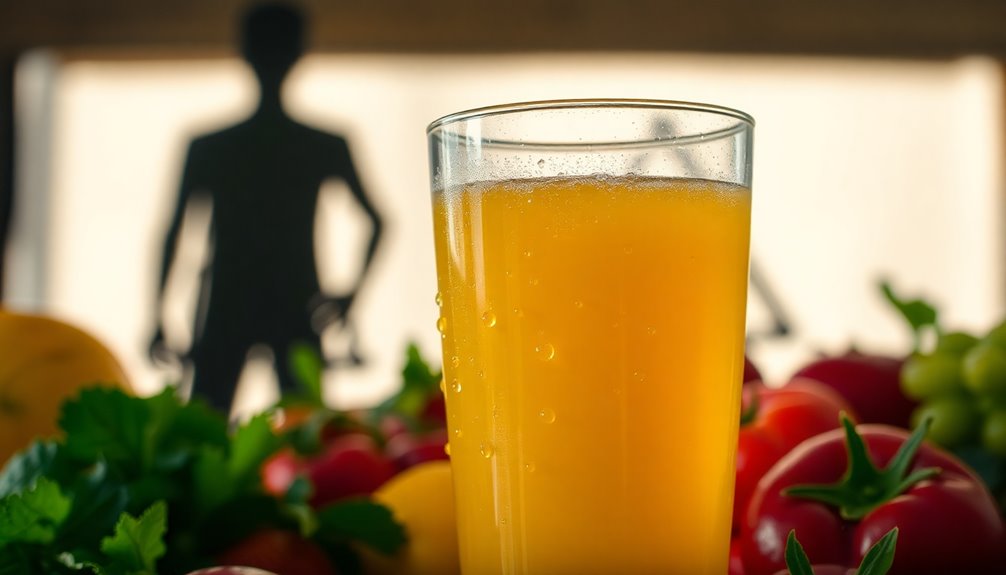
While many people enjoy the invigorating taste of juice, the health consequences of foodborne illnesses can be severe and far-reaching. Consuming unpasteurized juice exposes you to harmful bacteria like E. coli, Salmonella, and hepatitis A, which can lead to food poisoning.
The CDC estimates that 76 million foodborne illnesses occur annually in the U.S., with some resulting in permanent kidney damage, liver complications, or even death. Your immune system plays a vital role in fighting these infections, but if you're part of a vulnerable population, the risk of foodborne illness increases considerably.
Symptoms can take anywhere from 20 minutes to six weeks to appear, making awareness and prompt medical attention essential for recovery. Additionally, practicing mindfulness techniques can help enhance your overall well-being and resilience against health challenges. Stay informed to protect your health!
Vulnerable Populations at Greater Risk
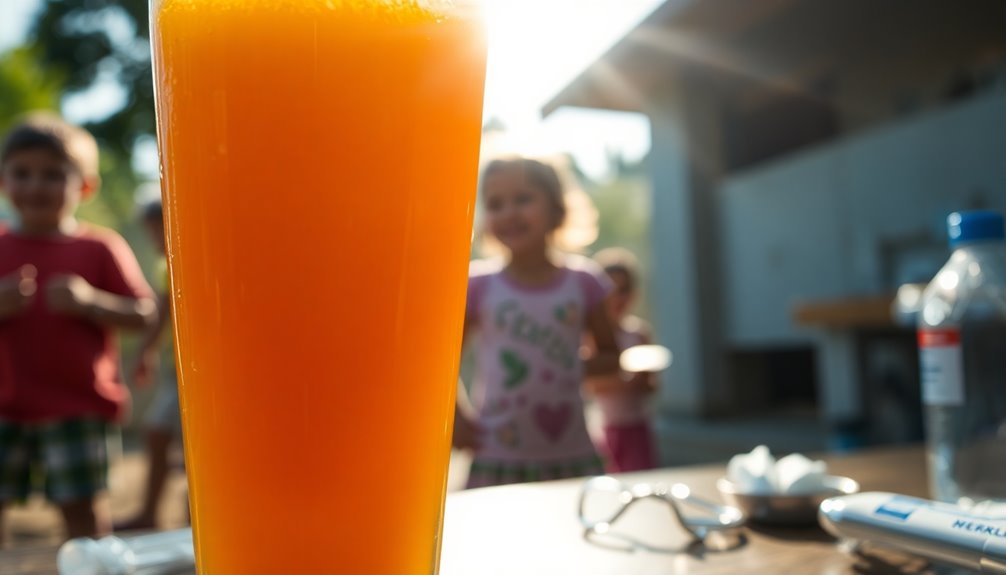
When it comes to unpasteurized juice, certain groups are especially at risk.
If you have young children, are pregnant, or have a weakened immune system, it's essential to be aware of the dangers.
These vulnerable populations face a higher likelihood of severe health issues from harmful pathogens found in unpasteurized juices.
Children Under Five
Young children, especially those under five, face significant risks from consuming unpasteurized juice due to their immature immune systems.
Their developing bodies are less capable of fighting off harmful pathogens, making them particularly vulnerable to foodborne illnesses. The CDC highlights that young children can suffer severe health effects from pathogens like toxigenic E. coli and Salmonella found in unpasteurized juice.
Illnesses can lead to serious complications, including permanent kidney damage.
- Avoid giving unpasteurized juices to children under five.
- Be cautious with fresh produce linked to foodborne illnesses.
- Follow FDA recommendations for your child's health.
Keeping these risks in mind can help protect your little ones from potentially severe health issues related to unpasteurized juice.
Pregnant Women
Expecting mothers must be particularly cautious about what they consume, including juices.
Pregnant people face heightened risks when it comes to unpasteurized juice, as their immune systems are weakened. These juices can harbor dangerous pathogens like Listeria monocytogenes, which can lead to severe complications such as miscarriage, stillbirth, or serious illness in newborns.
The FDA strongly recommends that pregnant individuals avoid unpasteurized juices and other raw products to prevent foodborne illnesses.
Consuming unpasteurized juice during pregnancy can even cause significant liver damage from pathogens like hepatitis A, putting both mother and baby at risk.
Awareness of these dangers is essential for ensuring a safer pregnancy and healthier outcomes for your child.
Stay informed and choose pasteurized options instead.
Immunocompromised Individuals
Since immunocompromised individuals have weakened immune systems, they must be especially vigilant about what they consume, particularly when it comes to unpasteurized juice.
The risks are significant; pathogens like E. coli and Salmonella thrive in these beverages, potentially leading to serious illness. The FDA strongly advises avoiding unpasteurized juice entirely due to the life-threatening infections it can cause.
To enhance food safety and protect your health, consider the following:
- Always choose pasteurized juices.
- Read labels carefully to avoid unpasteurized options.
- Consult with healthcare providers about safe dietary choices.
Identifying Pasteurized vs. Unpasteurized Juice
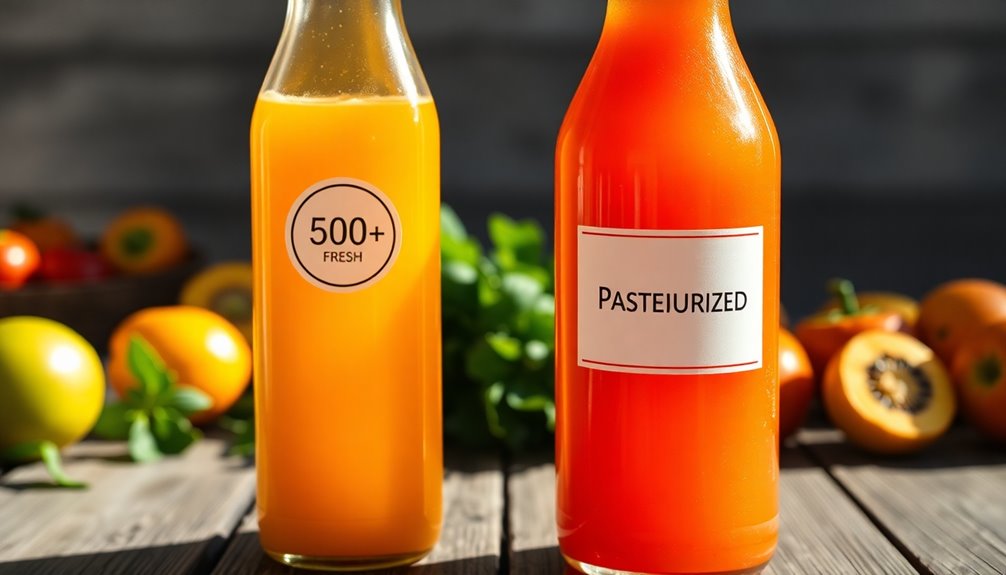
When you're choosing juice, it's essential to know how to identify pasteurized versus unpasteurized options.
Look for labels that indicate pasteurization or high-pressure processing to guarantee you're making a safe choice.
Visual Indicators of Pasteurization
Identifying whether juice is pasteurized or unpasteurized is essential for ensuring your safety.
Unpasteurized juices can pose a higher risk of foodborne illnesses, so knowing what to look for is vital. Here are some visual indicators to help you discern between the two:
- Check for the word "pasteurized" or "high pressure processed (HPP)" on the label.
- Look for warning labels on unpasteurized juices, especially in retail settings.
- Be cautious with fresh-squeezed juices in clear containers, as they're often unpasteurized.
Labeling and Safety Standards
Understanding the labeling and safety standards for juices can help you make informed choices about what you consume. Unpasteurized juices carry warning labels about harmful bacteria, while pasteurized ones usually don't. Be cautious, especially with fresh-squeezed juices in restaurants, as they might lack labels. The FDA mandates that untreated juices in stores mention foodborne illness risks to raise awareness.
| Juice Type | Labeling Requirement | Safety Standard |
|---|---|---|
| Unpasteurized Juice | Warning label required | Lacks strict testing |
| Pasteurized Juice | No warning label needed | Follows strict safety standards |
| Fresh-Squeezed | Often no label; inquire | Varies; often lacks testing |
Always check labels to verify you're choosing safely processed juices.
The Role of Refrigeration in Juice Safety

Refrigeration plays an essential role in ensuring the safety of unpasteurized juice, as it helps slow the growth of harmful pathogens.
The Food and Drug Administration recommends keeping unpasteurized juice refrigerated at temperatures below 40°F (4°C) to minimize the risk of bacterial contamination.
Remember, unpasteurized juice has a shorter shelf life, typically lasting only about three days.
To help you stay safe, consider these tips:
- Always check storage guidelines on labels.
- Consume refrigerated juice quickly to reduce the risk of foodborne illnesses.
- Be aware that failing to refrigerate can lead to rapid pathogen growth, increasing contamination risks. Additionally, dilution guidelines for essential oils are crucial for safety, highlighting the importance of proper handling in both food and aromatherapy contexts.
Safe Consumption Practices for Juice

When it comes to enjoying juice safely, knowing how to handle both pasteurized and unpasteurized options is key. To minimize risks, follow these safe consumption practices:
| Action | Pasteurized Juice | Unpasteurized Juice |
|---|---|---|
| Check labels | Always pasteurized | Verify pasteurization status |
| Refrigerate after opening | Keep refrigerated | Refrigerate immediately |
| Consumption timeframe | Consume by expiration date | Consume within a few days |
| Preparation tips | Ready to drink | Wash fruits/vegetables |
| At-risk populations | Safe for all | Avoid for vulnerable groups |
If you suspect foodborne illness, watch for symptoms like diarrhea or cramps, especially if you’ve consumed unpasteurized juice. Those with weakened immune systems should be particularly cautious. Additionally, it is essential to stay hydrated and seek medical attention if symptoms persist or worsen. Unpasteurized juices, including cranberry juice, may pose specific health risks that need to be understood; cranberry juice health concerns explained can provide insight into potential pathogens and their impact on health. Always prioritize safety by choosing pasteurized products, particularly for vulnerable populations.
Alternatives to Unpasteurized Juice
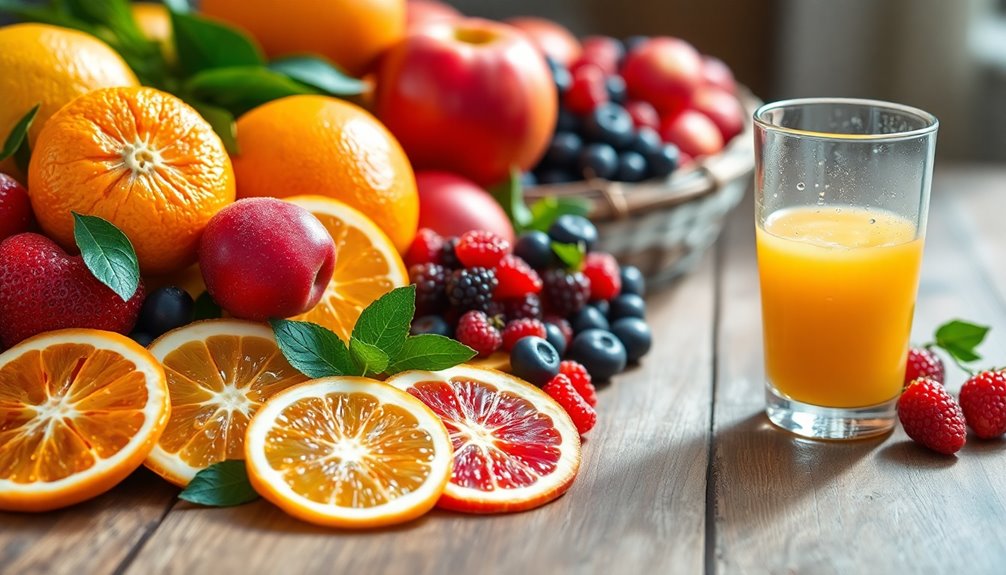
If you're looking for safer options, consider switching to pasteurized juice or whole fruits and vegetables. Choosing pasteurized juice greatly lowers your risk of foodborne illness by eliminating harmful pathogens like E. coli and Salmonella.
Whole fresh fruits and vegetables provide essential nutrients while minimizing bacterial contamination. For those who enjoy fresh juice, home pasteurization is an option; simply heat juice to at least 160°F (71°C) for one minute to kill harmful bacteria.
If you're at higher risk, such as pregnant women or the elderly, opting for pasteurized juices is strongly recommended. Additionally, incorporating options rich in vitamins A, C, and K can further support overall health.
- Enjoy a variety of whole fruits and vegetables for maximum nutrients.
- Look for commercially produced juices that aren't refrigerated.
- Consider home pasteurization for fresh juice safety.
Resources for Further Information

Exploring safer alternatives to unpasteurized juice leads to a need for reliable information on food safety.
The FDA emphasizes that unpasteurized juices pose health risks, particularly for pregnant individuals, young children, older adults, and immunocompromised individuals.
To stay informed, check the CDC's findings on foodborne illnesses, which estimate over 76 million cases annually linked to contaminated juices.
Always look for warning labels on juice products, especially at juice bars, where many fresh-squeezed options may lack proper labeling.
The Canadian Food Inspection Agency also offers a code of practice for unpasteurized juices, focusing on safe handling and storage.
Additionally, understanding the importance of food safety practices can help minimize health risks associated with consuming unpasteurized products.
Frequently Asked Questions
What Are the Risks of Unpasteurized Juice?
When you drink unpasteurized juice, you're exposing yourself to serious health risks.
Pathogens like E. coli and Salmonella can lurk in these beverages, increasing your chances of foodborne illnesses. If you're in a vulnerable group—like young children, the elderly, or pregnant women—the risks heighten considerably.
Even washing fruits doesn't eliminate harmful bacteria. To protect your health, it's wise to stick to pasteurized juices, especially if you're in an at-risk category.
What Is the Warning Label for Unpasteurized Juice?
Imagine you're at your favorite juice bar, and you spot a vibrant, fresh-squeezed juice.
Before you order, you should know that unpasteurized juices often come with warning labels.
These labels inform you about potential risks of harmful bacteria that can affect your health, especially if you're among vulnerable groups.
Always check for these warnings, so you can make informed choices and enjoy your juice without compromising your wellbeing!
How Can You Tell if Juice Is Unpasteurized?
To tell if juice is unpasteurized, check for warning labels that indicate it's "raw" or "fresh squeezed."
These labels are usually required for store-bought untreated juices.
If you're at a juice bar or restaurant, don't hesitate to ask about their pasteurization status, as they mightn't have labels.
Also, remember that unpasteurized juices need to be refrigerated and consumed quickly, typically within a few days, unlike pasteurized options.
What Happens if You Drink Unpasteurized Apple Juice?
If you indulge in unpasteurized apple juice, you might just be inviting a few unwelcome guests into your system.
These pathogens can lead to foodborne illnesses, causing symptoms like nausea, diarrhea, and abdominal pain.
While it may seem invigorating, the risk is particularly concerning for vulnerable groups.
You wouldn't want to feel unwell, so it's wise to choose pasteurized options that guarantee your health and safety without compromising your enjoyment.
Conclusion
In the world of juice, it's crucial to know what you're getting. Unpasteurized juice may seem fresh and natural, but it can pose significant health risks that you shouldn't overlook. By keeping your eyes peeled for pasteurized options and following safe consumption practices, you can enjoy your juice without a hitch. Remember, it's better to be safe than sorry—make informed choices to protect yourself and your loved ones from potential foodborne illnesses. Stay healthy!
Cindy thoroughly researches juicing trends, techniques, and recipes to provide readers with practical advice and inspiration. Her writing style is accessible, engaging, and designed to make complex concepts easy to understand. Cindy’s dedication to promoting the advantages of juicing shines through her work, empowering readers to make positive changes in their lives through the simple act of juicing.




